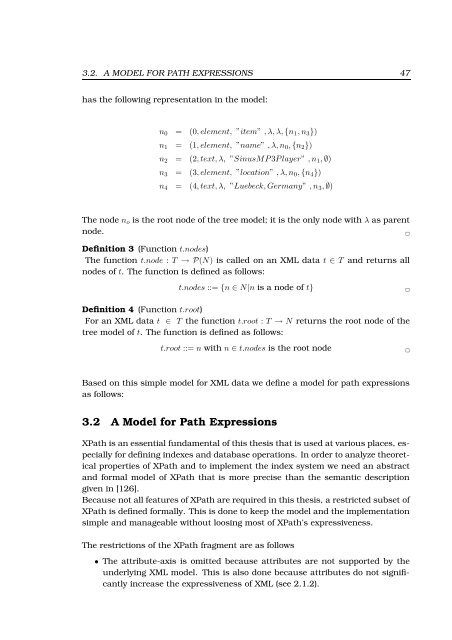url - Universität zu Lübeck
url - Universität zu Lübeck
url - Universität zu Lübeck
You also want an ePaper? Increase the reach of your titles
YUMPU automatically turns print PDFs into web optimized ePapers that Google loves.
3.2. A MODEL FOR PATH EXPRESSIONS 47<br />
has the following representation in the model:<br />
n 0 = (0, element, ”item” , λ, λ, {n 1 , n 3 })<br />
n 1 = (1, element, ”name” , λ, n 0 , {n 2 })<br />
n 2 = (2, text, λ, ”SinusMP 3P layer” , n 1 , ∅)<br />
n 3 = (3, element, ”location” , λ, n 0 , {n 4 })<br />
n 4 = (4, text, λ, ”Luebeck, Germany” , n 3 , ∅)<br />
The node n o is the root node of the tree model; it is the only node with λ as parent<br />
node.<br />
<br />
Definition 3 (Function t.nodes)<br />
The function t.node : T → P(N) is called on an XML data t ∈ T and returns all<br />
nodes of t. The function is defined as follows:<br />
t.nodes ::= {n ∈ N|n is a node of t}<br />
<br />
Definition 4 (Function t.root)<br />
For an XML data t ∈ T the function t.root : T → N returns the root node of the<br />
tree model of t. The function is defined as follows:<br />
t.root ::= n with n ∈ t.nodes is the root node<br />
<br />
Based on this simple model for XML data we define a model for path expressions<br />
as follows:<br />
3.2 A Model for Path Expressions<br />
XPath is an essential fundamental of this thesis that is used at various places, especially<br />
for defining indexes and database operations. In order to analyze theoretical<br />
properties of XPath and to implement the index system we need an abstract<br />
and formal model of XPath that is more precise than the semantic description<br />
given in [126].<br />
Because not all features of XPath are required in this thesis, a restricted subset of<br />
XPath is defined formally. This is done to keep the model and the implementation<br />
simple and manageable without loosing most of XPath’s expressiveness.<br />
The restrictions of the XPath fragment are as follows<br />
• The attribute-axis is omitted because attributes are not supported by the<br />
underlying XML model. This is also done because attributes do not significantly<br />
increase the expressiveness of XML (see 2.1.2).
















